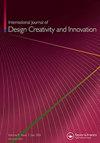编辑
IF 2.5
Q4 ENGINEERING, MANUFACTURING
International Journal of Design Creativity and Innovation
Pub Date : 2020-04-02
DOI:10.1080/21650349.2020.1730613
引用次数: 0
摘要
正如奈杰尔·克罗斯(Nigel Cross)的名言所指出的那样(“每个人都可以——也确实可以——设计”),每当我们计划和执行行动来改变外部世界时,设计就会发生。设计正变得越来越复杂,尤其是当目标是生产出新的、有价值的东西供某些目标社区采用时,即当我们为创新而设计时。大量研究表明,创造力在设计创新活动中发挥着关键作用。这就体现了在不同但相互连接的流中阐明设计创意研究的重要性,从而涵盖灵感、构思和实施的所有阶段,包括设计成果的最终利用。目前出版的《国际设计创意与创新杂志》很好地展现了设计创意研究的多方面面貌,其贡献从设计环境对设计灵感的影响到设计的商业模式创新。更具体地说,So的第一篇论文“具象设计:设计灵感和情绪改善取决于感知的刺激源,并预测对沉浸体验的满意度”通过分析刺激类别(如位置和被动/主动互动)之间的差异,丰富了关于富刺激环境对设计灵感影响的讨论。此外,它还展示了情绪的改善如何成为设计灵感的催化剂。众所周知,设计师的一个非常重要的角色是预测用户和其他利益相关者对产品的看法。在影响因素中,产品形状的拓扑特性会影响用户的注意力,正如费和Nagai在第二篇论文“产品形状注意力的拓扑感知”中的实验活动所讨论的那样。由于拓扑变化比其他类型的变化更吸引眼球,因此它们可以用于突出技术转变,以及产品的创新特征。对用户感知的调查通常涉及原型设计阶段,以探索并行设计概念并收集他们的反馈。原型设计在教育活动中也至关重要,因为它可以培养更丰富的能力和技能,从而影响设计选择,并最终影响个人创造力。不太常见的是在大规模开放在线课程(MOOC)中使用原型,但在线学习平台的全球传播使该主题与设计教育的未来发展极为相关。在这一主题上,Jablokow等人的论文“探索全球在线学习环境中创意原型的多样性”分析了性别、原籍国和职业之间的原型制作性能差异。了解个人的这种特征如何与不同的设计绩效指标相关联,有助于进一步阐明多样性对设计创造力的影响。Bryant等人的第四篇论文《通过设计进行商业模式创新:设计在商业模式创新中的作用综述》对这一问题进行了总结,讨论了设计在商业模型创新中的促进作用,但也表明,该领域的科学文献中有很大一部分涉及设计,而对设计知识体系的进步没有真正做出任何贡献。论文还揭示了只有一种商业模式创新机制反映了经典的工业设计实践,并且在新兴设计方法的启发下探索新的模式和技术的可能性很大。本文章由计算机程序翻译,如有差异,请以英文原文为准。
Editorial
As the famous quote by Nigel Cross indicates (‘Everyone can – and does – design’), designing occurs whenever we plan and execute actions to create changes in the external world. Design is becoming increasingly complex especially when the goal is to produce something new and valuable to be adopted by some target community, i.e., when we are designing for innovation. Ample research has shown that creativity plays a key role in designing for innovation activities. Therein lies the importance of articulating design creativity research in diverse yet connected streams, so as to cover all stages of inspiration, ideation and implementation, including the final exploitation of the design outcome. The current issue of the International Journal of Design Creativity and Innovation represents well the multifaceted landscape of design creativity research, with contributions ranging from the impact of the design environment on design inspiration to the business-model innovation by design. More specifically, the first paper ‘Embodied design: Design inspiration and mood improvement depend on perceived stimulus sources and predict satisfaction with an immersion experience’ by So enriches the discussion about the influence of a stimulus-rich environment on design inspiration by analyzing the difference between stimulus categories such as location, and passive/active interactions. Furthermore, it shows howmood improvement serves as a catalyst for design inspiration. It is widely known that a very important role of designers is to anticipate how users and other stakeholders will perceive the products. Among influential factors, topological properties of a product shape can affect the user’s attention, as discussed through an experimental activity in the second paper, ‘Topological perception on attention to product shape’ by Fei and Nagai. As topological variations attract attention more than other types of variation, they could be used for highlighting technological shifts and, in general, the innovative features of a product. The investigation of user’s perceptions typically involves a prototyping stage to explore parallel design concepts and gather their feedback. Prototyping has paramount importance also in educational activities, as it allows developing richer competencies and skills that impact design choices and, ultimately, individual creativity. Less common is the exploitation of prototyping in Massive Open Online Courses (MOOCs), but the global diffusion of online learning platforms makes the topic extremely relevant for future developments in design education. On this thread, the paper ‘Exploring the diversity of creative prototyping in a global online learning environment’ by Jablokow et al. analyzes prototyping performance differences between genders, countries of origin and occupations. Understanding how this kind of characteristics of individuals are associated with different design performance measures could be helpful to further clarify the impact of diversity on design creativity. The fourth paper ‘Business model innovation by design: a review of design’s role in business model innovation’ by Bryant et al. concludes this issue discussing the facilitating role that design can play in the innovation of business models, but also showing that a large proportion of the scientific literature in the field refers to design without really contributing anything to the advancement of the design body of knowledge. The paper also reveals that only one of the business model innovation mechanisms reflects the classical industrial design practice, and that there is a large possibility of exploring new models and techniques inspired by emerging design approaches.
求助全文
通过发布文献求助,成功后即可免费获取论文全文。
去求助
来源期刊

International Journal of Design Creativity and Innovation
ENGINEERING, MANUFACTURING-
CiteScore
3.80
自引率
27.80%
发文量
15
期刊介绍:
The International Journal of Design Creativity and Innovation is an international publication that provides a forum for discussing the nature and potential of creativity and innovation in design from both theoretical and practical perspectives. Design creativity and innovation is truly an interdisciplinary academic research field that will interest and stimulate researchers of engineering design, industrial design, architecture, art, and similar areas. The journal aims to not only promote existing research disciplines but also pioneer a new one that lies in the intermediate area between the domains of systems engineering, information technology, computer science, social science, artificial intelligence, cognitive science, psychology, philosophy, linguistics, and related fields. The journal covers, but is not restricted to, the following topics: ·Theories on Design Creativity and Innovation ·Cognition of Design Creativity ·Innovative Process ·Inventive Process ·Analogical Reasoning for Design Creativity and Innovation ·Design Synthesis ·Method and Tools for Design Creativity and Innovation ·Representation of Design Creativity and Innovation ·Education for Design Creativity and Innovation ·Concept Generation and Inspiration.
 求助内容:
求助内容: 应助结果提醒方式:
应助结果提醒方式:


